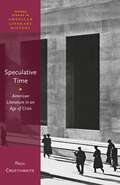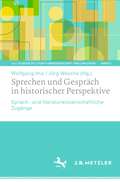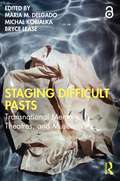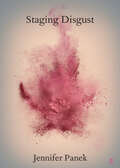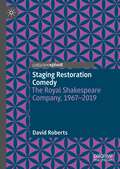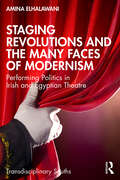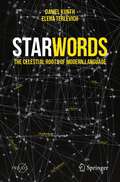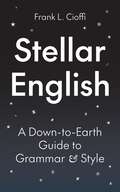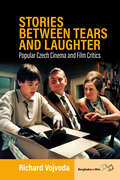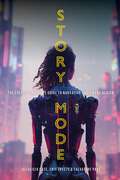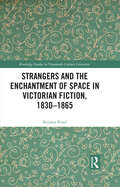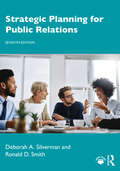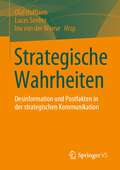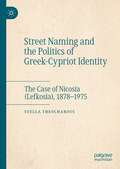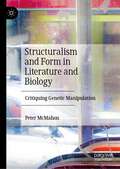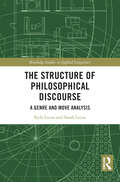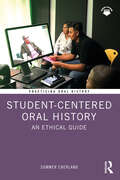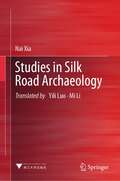- Table View
- List View
Speculative Time: American Literature in an Age of Crisis (Oxford Studies in American Literary History)
by Paul CrosthwaiteSpeculative Time: American Literature in an Age of Crisis examines how a climate of financial and economic speculation and disaster shaped the literary culture of the United States in the early to mid-twentieth century. It argues that speculation's risk-laden and crisis-prone temporalities had major impacts on writing in the period, as well as on important aspects of visual representation. The conceptions of time-and especially futurity-arising from the theory and practice of speculation provided crucial models for writers' and other artists' aesthetic, intellectual, and political concerns and strategies. The attractions and dangers of speculation were most spectacularly apparent in the period's pivotal economic event: the Wall Street Crash of 1929. The book offers an innovative account of how the speculative boom and bust of the "Roaring Twenties" affected literary and cultural production in the United States. It situates the stock market gyrations of the 1920s and 1930s within a wider culture of speculation that was profoundly shaped by, but extended well beyond, the brokerages and trading floors of Wall Street. The early to mid-twentieth century was a “speculative time,” an age characterized by leaps of economic, political, intellectual, and literary speculation; and the notion of speculative time provides a means of understanding the period's characteristic temporal modes and textures, as evident in work by figures including F. Scott Fitzgerald, John Dos Passos, Nathan Asch, William Faulkner, Federico García Lorca, James N. Rosenberg, Margaret Bourke-White, Archibald MacLeish, Christina Stead, Claude McKay, Richard Wright, and Ralph Ellison.
Spielformen der Störung: Ror Wolfs radikaler Realismus im Kontext experimenteller Prosa der 1950er-1980er Jahre (Lettre)
by Barbara BauschWeltabgewandter Sprachspieler oder »radikaler Realist«? Fremd- und Selbstzuschreibung gehen in Bezug auf den Autor Ror Wolf weit auseinander. Dies gründet auf einer nur scheinbaren Paradoxie: In Wolfs vielgestaltigem Werk vollzieht sich der Zugriff auf Wirklichkeit gerade im Modus der Sabotage, Unterbrechung, Irritation oder Verzerrung - kurz: im Modus der Störung. Ausgehend von der langen Prosa fragt Barbara Bausch nach möglichen Formen literarischer Referenzialität. Dabei konturiert sie Ror Wolfs experimentelle und zugleich engagierte Poetik des ästhetisch produktiven Störens als Kreuzungspunkt verschiedenster Suchbewegungen des Prosaschreibens in den 1950er bis 1980er Jahren.
Sprechen und Gespräch in historischer Perspektive: Sprach- und literaturwissenschaftliche Zugänge (LiLi: Studien zu Literaturwissenschaft und Linguistik #7)
by Wolfgang Imo Jörg WescheInfolge der pragmatischen Wende in der Germanistik werden die Arbeitsweisen der linguistischen Dialog- und Interaktionsforschung zunehmend mit sprachhistorischen Fragestellungen verknüpft – empirische Erkenntnisse zur heutigen gesprochenen Sprache sollen helfen, Strukturen gesprochener Sprache früherer Epochen zu rekonstruieren. Die Beiträge des Bandes loten die Möglichkeiten und Grenzen interaktionaler, dialogischer bzw. nähesprachlicher Analysen historischer Texte aus. Die linguistischen Beiträge fokussieren Analysemethoden zur Erforschung von Nähesprachlichkeit, die literaturwissenschaftlichen Arbeiten rhetorische Techniken und die ästhetische Inszenierung von Mündlichkeit.
Staging Difficult Pasts: Transnational Memory, Theatres, and Museums
by Maria M. Delgado Michal Kobialka Bryce LeaseThis collection of original essays brings together museum, theatre, and performance case studies with a focus on their distinctive and overlapping modes of producing memory for transnational audiences. Whether this is through narrative, object, embodied encounter or a combination of the three, this volume considers distinctions and interactions between memory and history specifically through the lenses of theatre and performance studies, visual culture, and museum and curator studies. This book is underpinned by three areas of research enquiry: How are contemporary theatre makers and museum curators staging historical narratives of difficult pasts? How might comparisons between theatre and museum practices offer new insights into the role objects play in generating and representing difficult pasts? What points of overlap, comparison, and contrast among these constructions of history and memory of authoritarianism, slavery, colonialism, genocide, armed conflict, fascism, and communism might offer an expanded understanding of difficult pasts in these transnational cultural contexts? This collection is designed for any scholar of its central disciplines, as well as for those interested in cultural geography, memory studies, and postcolonial theory. The Open Access version of this book, available at http://www.taylorfrancis.com, has been made available under a Creative Commons Attribution-NoDerivatives (CC-BY-ND) 4.0 license.
Staging Difficult Pasts: Transnational Memory, Theatres, and Museums
This collection of original essays brings together museum, theatre, and performance case studies with a focus on their distinctive and overlapping modes of producing memory for transnational audiences. Whether this is through narrative, object, embodied encounter or a combination of the three, this volume considers distinctions and interactions between memory and history specifically through the lenses of theatre and performance studies, visual culture, and museum and curator studies. This book is underpinned by three areas of research enquiry: How are contemporary theatre makers and museum curators staging historical narratives of difficult pasts? How might comparisons between theatre and museum practices offer new insights into the role objects play in generating and representing difficult pasts? What points of overlap, comparison, and contrast among these constructions of history and memory of authoritarianism, slavery, colonialism, genocide, armed conflict, fascism, and communism might offer an expanded understanding of difficult pasts in these transnational cultural contexts? This collection is designed for any scholar of its central disciplines, as well as for those interested in cultural geography, memory studies, and postcolonial theory. The Open Access version of this book, available at http://www.taylorfrancis.com, has been made available under a Creative Commons Attribution-NoDerivatives (CC-BY-ND) 4.0 license.
Staging Disgust: Rape, Shame, and Performance in Shakespeare and Middleton (Elements in Shakespeare Performance)
by null Jennifer PanekThis Element turns to the stage to ask a simple question about gender and affect: what causes the shame of the early modern rape victim? Beneath honour codes and problematic assumptions about consent, the answer lies in affect, disgust. It explores both the textual "performance" of affect, how literary language works to evoke emotions and the ways disgust can work in theatrical performance. Here Shakespeare's poem The Rape of Lucrece is the classic paradigm of sexual pollution and shame, where disgust's irrational logic of contamination leaves the raped wife in a permanent state of uncleanness that spreads from body to soul. Staging Disgust offers alternatives to this depressing trajectory: Middleton's Women Beware Women and Shakespeare's Titus Andronicus perform disgust with a difference, deploying the audience's revulsion to challenge the assumption that a raped woman should “naturally” feel intolerable shame.
Staging Restoration Comedy: The Royal Shakespeare Company, 1967-2019
by David RobertsSince its 1967 production of Vanbrugh’s The Relapse, the Royal Shakespeare Company has been the world’s leading producer of Restoration Comedies. This book is the first to document and critique the company’s history of engagement with that repertoire. It reviews the spaces in which productions have been performed, design principles, casting, voicing, textual adaptation, musical direction, actor perspectives, and the problems of how to confront, adopt or depart from received notions of Restoration style. It goes on to posit that, for all the RSC’s explorations of Restoration Comedy, the company has maintained the repertoire as a fringe interest played out in niche spaces, while recycling many of the assumptions it claims to challenge, and that what is needed is the writer-led intervention seen in RSC and National Theatre adaptations of French drama from the same period. Only then can Restoration Comedy begin to engage wider audiences in new sites of political, historical andcultural meaning.
Staging Revolutions and the Many Faces of Modernism: Performing Politics in Irish and Egyptian Theatre (Transdisciplinary Souths)
by Amina ElHalawaniThe book explores how theatre, with its performative capacity, has the power to engage with and affect the politics of its day. It sets the stage for the reader to discover the revolutionary traditions of Egyptian and Irish theatre, very distinct in their histories and cultures, and understand their enduring relevance in today’s world. The volume takes Ireland as a case study of the interplay between cultural nationalism and politically engaged theatre and compares it to the role of the theatre in Egypt during its Golden era in the 1960s.Through a selection of Egyptian plays by Tawfiq al-Hakim, Mikhail Roman, Yusuf Idris, and Salah Abdul-Saboor, alongside Irish plays by Brian Friel, Frank McGuinness, Christina Reid, and Samuel Beckett, it maps the political aesthetics of unsteady times and seemingly disparate places to reflect on the dynamics of revolt as a staged act in and of itself. Further, the book examines how playwrights from both nations have engaged with theatre as a medium, focusing on how their contemplations, hesitations, frustrations, and protest have been translated onto the stage in their various plays, and comprehends the transformative role the theatre has always played in politics in shaping history across time and space.Bridging together discussions on transnational modernisms with nuanced cultural histories of protest, this critical work will be of great interest to scholars and researchers of literary studies, identity politics, cultural studies, theatre and performance studies, and political studies.
Staging Revolutions and the Many Faces of Modernism: Performing Politics in Irish and Egyptian Theatre (Transdisciplinary Souths)
by Amina ElHalawaniThe book explores how theatre, with its performative capacity, has the power to engage with and affect the politics of its day. It sets the stage for the reader to discover the revolutionary traditions of Egyptian and Irish theatre, very distinct in their histories and cultures, and understand their enduring relevance in today’s world. The volume takes Ireland as a case study of the interplay between cultural nationalism and politically engaged theatre and compares it to the role of the theatre in Egypt during its Golden era in the 1960s.Through a selection of Egyptian plays by Tawfiq al-Hakim, Mikhail Roman, Yusuf Idris, and Salah Abdul-Saboor, alongside Irish plays by Brian Friel, Frank McGuinness, Christina Reid, and Samuel Beckett, it maps the political aesthetics of unsteady times and seemingly disparate places to reflect on the dynamics of revolt as a staged act in and of itself. Further, the book examines how playwrights from both nations have engaged with theatre as a medium, focusing on how their contemplations, hesitations, frustrations, and protest have been translated onto the stage in their various plays, and comprehends the transformative role the theatre has always played in politics in shaping history across time and space.Bridging together discussions on transnational modernisms with nuanced cultural histories of protest, this critical work will be of great interest to scholars and researchers of literary studies, identity politics, cultural studies, theatre and performance studies, and political studies.
StarWords: The Celestial Roots of Modern Language (Springer Praxis Books)
by Daniel Kunth Elena TerlevichUnbeknownst to many, our modern language contains countless words that were inspired by human observations of the cosmos. We now use words like “zenith”, “Monday”, “disaster”, “dog days”, “starfish”, “lunatic”, flu, and so many others, without a second thought for their celestial roots. Famous French astrophysicist Daniel Kunth invites you on a linguistic and scientific journey through space and time to explore these forgotten origins. You will be astonished to rediscover cosmic language hidden in plain sight through this wonderful collection of historical and cultural stories, famous idioms and delightful puns, along with the real science behind each one. Elena Terlevich is a well known professional astronomer working at INAOE in Mexico, an honorary Professor at La Plata University in Argentina and a regular visitor at the Institute of Astronomy in Cambridge (UK). Requiring no prior knowledge in astronomy or linguistics, this book’s universal contentsinvite the reader to ponder how our observations of the night sky have shaped our modern tongue and customs.
Stellar English: A Down-to-Earth Guide to Grammar and Style (Skills for Scholars)
by Frank L. CioffiAn indispensable guide to essential principles of English grammar and usageStellar English lays out the fundamentals of effective writing, from word choice and punctuation to parts of speech and common errors. Frank Cioffi emphasizes how formal written English—though only a subdialect of the language—enables writers to reach a wide and heterogenous audience.Cioffi&’s many example sentences illustrating grammatical principles tilt in an otherworldly direction, making up a science fiction story involving alien invasion. Reading the book through will not only help you with your grammar but also reveal how the story ends!An invaluable brief handbook for native and nonnative speakers alike, Stellar English avoids the jargon and emphasis on outdated rules found in typical grammar guides and shows how good writing uses carefully constructed language that&’s at once appropriate to an audience and communicates—without distractions or confusion—just what the writer wants.
Stories between Tears and Laughter: Popular Czech Cinema and Film Critics
by Richard VojvodaWhile histories of Czech cinema often highlight the quality of Czechoslovak New Wave films made in the 1960s, post-socialist Czech cinema receives little attention. Through a methodology of historical reception, Stories between Tears and Laughter explores how attitudes towards post-socialist Czech cinema have shifted from viewing it as radical “art cinema” and more towards popular cinema. By analyzing publicity materials, reviews, and articles, Richard Vojvoda offers a new perspective on the notions of cultural value and quality that have been shaping the history of post-socialist Czech cinema.
Story Mode: The Creative Writer's Guide to Narrative Video Game Design
by Professor Julialicia Case Professor Eric Freeze Professor Salvatore PaneAgainst the backdrop of a hyper-competitive AAA industry and the perception that it is a world reserved for top programmers and hard-core 'gamers', Story Mode offers an accessible entry-point for all into writing and designing complex and emotionally affecting narrative video games. The first textbook to combine game design with creative writing techniques, this much-needed resource makes the skills necessary to consume and create digital and multi-modal stories attainable and fun. Appealing to the growing calls for greater inclusivity and access to this important contemporary apparatus of expression, this book offers low-cost, accessible tools and instruction that bridge the knowledge gap for creative writers, showing them how they can merge their skill-set with the fundamentals of game creation and empowering them to produce their own games which push stories beyond the page and the written word. Broken down into 4 sections to best orientate writers from any technological background to the strategies of game production, this book offers: - Contextual and introductory chapters exploring the history and variety of various game genres. - Discussions of how traditional creative writing approaches to character, plot, world-building and dialogue can be utilised in game writing. - An in-depth overview of game studies concepts such as game construction, interactivity, audience engagement, empathy, real-world change and representation that orientate writers to approach games from the perspective of a designer. - A whole section on the practical elements of work-shopping, tools, collaborative writing as well as extended exercises guiding readers through long-term, collaborative, game-centred projects using suites and tools like Twine, Audacity, Bitsy, and GameMaker. Featuring detailed craft lessons, hands-on exercises and case studies, this is the ultimate guide for creative writers wanting to diversify into writing for interactive, digital and contemporary modes of storytelling. Designed not to lay out a roadmap to a successful career in the games industry but to empower writers to experiment in a medium previously regarded as exclusive, this book demystifies the process behind creating video games, orienting readers to a wide range of new possible forms and inspiring them to challenge mainstream notions of what video games can be and become.
Strangers and the Enchantment of Space in Victorian Fiction, 1830–1865 (Routledge Studies in Nineteenth Century Literature)
by Kristen PondTracing the origins of how we think about strangers to the Victorian period, Strangers and the Enchantment of Space in Victorian Fiction, 1830-1865 explores the vital role strangers had in shaping social relations during the cultural transformations of the industrial revolution, transportation technologies, and globalization. While studies of nineteenth-century Britain tend to trace the rise of an aloof cosmopolitanism and distancing narrative strategies, this volume calls attention to the personalizing impulse in nineteenth-century literary form, investigating the deeply personal reflections on individual and national identities. In her book, Dr. Pond leads the reader through homes of the urban poor, wandering the Great Exhibition in the Crystal Palace, loitering in suburban neighborhoods, riding the railway, and touring a country estate. Readers will experience how the ordinary can be enchanting, and how the mundane can be unexpected, discovering a new way of thinking about strangers and their influence on our lives. Through an examination of the short and long fictional forms of Martineau, Dickens, Brontë, Gaskell, and Braddon, this study locates the figure of the stranger as a powerful topos in the story Victorian literature and the ethics of social relations. This book will be ideal for those seeking to understand the dynamics of the stranger in Victorian fiction as a figure for understanding the changing dynamics of social relations in England in the early nineteenth century.
Strangers and the Enchantment of Space in Victorian Fiction, 1830–1865 (Routledge Studies in Nineteenth Century Literature)
by Kristen PondTracing the origins of how we think about strangers to the Victorian period, Strangers and the Enchantment of Space in Victorian Fiction, 1830-1865 explores the vital role strangers had in shaping social relations during the cultural transformations of the industrial revolution, transportation technologies, and globalization. While studies of nineteenth-century Britain tend to trace the rise of an aloof cosmopolitanism and distancing narrative strategies, this volume calls attention to the personalizing impulse in nineteenth-century literary form, investigating the deeply personal reflections on individual and national identities. In her book, Dr. Pond leads the reader through homes of the urban poor, wandering the Great Exhibition in the Crystal Palace, loitering in suburban neighborhoods, riding the railway, and touring a country estate. Readers will experience how the ordinary can be enchanting, and how the mundane can be unexpected, discovering a new way of thinking about strangers and their influence on our lives. Through an examination of the short and long fictional forms of Martineau, Dickens, Brontë, Gaskell, and Braddon, this study locates the figure of the stranger as a powerful topos in the story Victorian literature and the ethics of social relations. This book will be ideal for those seeking to understand the dynamics of the stranger in Victorian fiction as a figure for understanding the changing dynamics of social relations in England in the early nineteenth century.
Strategic Planning for Public Relations
by Deborah A. Silverman Ronald D. SmithThe seventh edition of Strategic Planning for Public Relations maintains its status as a leading text to guide students in developing successful public relations campaigns.Deborah Silverman and Ronald Smith bring their experience as instructors and public relations professionals to the book, providing clear, step-by-step guidance on how to plan and implement strategic communications campaigns. This new edition includes diverse examples of current cases along with classic cases that stand the test of time. It includes new “Ethics Minutes” scenarios in each step, a new research step, and examples of award-winning public relations campaigns. It also significantly increases information on social media and features a reformatting of the tactics step into four separate parts based on the PESO model (paid media, earned media, shared media, and owned media).As a leader in teaching public relations strategy, this text is ideal for students in upper division undergraduate and graduate courses in public relations strategy and campaigns.Complementing the book are online resources for both students and instructors. For students: step overviews, useful links to professional organizations and resources, checklists for the ten steps in the planning process, and two sample campaigns. For instructors: an instructors’ manual, PowerPoint slides, sample syllabi, a critique evaluation worksheet, and checklists for the ten steps in the planning process. For these online resources, please visit www.routledge.com/9781032391168 .
Strategic Planning for Public Relations
by Deborah A. Silverman Ronald D. SmithThe seventh edition of Strategic Planning for Public Relations maintains its status as a leading text to guide students in developing successful public relations campaigns.Deborah Silverman and Ronald Smith bring their experience as instructors and public relations professionals to the book, providing clear, step-by-step guidance on how to plan and implement strategic communications campaigns. This new edition includes diverse examples of current cases along with classic cases that stand the test of time. It includes new “Ethics Minutes” scenarios in each step, a new research step, and examples of award-winning public relations campaigns. It also significantly increases information on social media and features a reformatting of the tactics step into four separate parts based on the PESO model (paid media, earned media, shared media, and owned media).As a leader in teaching public relations strategy, this text is ideal for students in upper division undergraduate and graduate courses in public relations strategy and campaigns.Complementing the book are online resources for both students and instructors. For students: step overviews, useful links to professional organizations and resources, checklists for the ten steps in the planning process, and two sample campaigns. For instructors: an instructors’ manual, PowerPoint slides, sample syllabi, a critique evaluation worksheet, and checklists for the ten steps in the planning process. For these online resources, please visit www.routledge.com/9781032391168 .
Strategische Wahrheiten: Desinformation und Postfakten in der strategischen Kommunikation
by Olaf Hoffjann Lucas Seeber Ina von der WenseStrategische Kommunikation zielt mit ihren kontingenten Wirklichkeitsbeschreibungen seit jeher auf gesellschaftliche Wahrheitsmodelle. Wie häufig gesellschaftliche Wahrheitsmodelle auf strategische Kommunikationsbemühungen zurückgehen, auf Unwahrhaftigkeit beruhen und damit zumindest zeitweise zu strategischen Wahrheiten werden, zeigen eindrucksvoll zwischenzeitlich geglaubte Wahrheiten, die sich als Lüge entpuppt haben: von Walter Ulbrichts „Niemand hat die Absicht, eine Mauer zu errichten“ über Hitlers Tagebücher bis hin zu den Massenvernichtungswaffen im Irak. Die erfolgreichen Kampagnen der Brexiteers und von Donald Trump 2016 haben diesem Thema zu neuer und bislang ungeahnter Aufmerksamkeit verholfen. Während die Themen Desinformation und postfaktische Gesellschaft die Journalismus-, politische Kommunikations- und Medienethikforschung aktuell zu dominieren scheinen, ist das Schweigen der deutschsprachigen und internationalen PR- und Organisationskommunikationsforschung auffällig. Dies ist umso bemerkenswerter, weil die PR-Wissenschaft in der Vergangenheit immer wieder versucht hat, ihren Gegenstand zu schärfen, indem sie sich am Begriff der Propaganda abgearbeitet hat. Daraus müsste eigentlich eine Affinität für das Thema Desinformation resultieren. Aber genau das Gegenteil ist offensichtlich der Fall: Hat sich die PR-Wissenschaft gerade deshalb nicht mit Desinformation beschäftigt, weil sie sich so dezidiert von Propaganda und darin eingeschlossenen desinformierenden und manipulativen Techniken abgrenzen will? Was sind die Gründe hierfür? Glauben wir, bereits alles zum Thema gesagt zu haben? Liegt dies daran, dass sich die PR- und Organisationskommunikationsforschung seit jeher vor allem für Unternehmen und weniger für politische und Non-Profit-Organisationen interessiert? Oder fühlen wir uns hier schlicht und ergreifend nicht zuständig? Es scheint offenkundig höchste Zeit zu sein, sich wieder eingehend mit Fragen der Desinformation aus der Perspektive der strategischen Kommunikationsforschung zu befassen. Die Beiträge des Tagungsbandes fokussieren hierzu auf neue theoretische Perspektiven, normative Bewertungen und empirische Befunde.
Street Naming and the Politics of Greek-Cypriot Identity: The Case of Nicosia (Lefkosia), 1878–1975
by Stella TheocharousThis book is the first to explore street names and street-naming in the formation of a Greek-Cypriot identity in the cityscape of Nicosia between 1878 and 1975. Rather than treating toponymy as a direct linguistic act of spatial orientation, the book approaches street-naming as a contested practice involving those shared symbols and representations used to depict official history and collective identity as part of a political process. It considers how street names are part of the symbolic politics of space, and how authorities transformed the streets of Nicosia into arenas of struggle for the control of symbolic and material space. It documents historical efforts over the course of a century to impose a ‘geography of forgetting’ to buttress national identity and to cast out the ‘other’ from space — both literally and symbolically — so as to achieve territorial dominance and political legitimacy. The book is another step towards the development of a global perspective on the critical study of street-naming, thereby refining and expanding our knowledge of the political dynamics involved in the process. In their commemorative capacity, street names belong to the politics of public memory and identity.
Structuralism and Form in Literature and Biology: Critiquing Genetic Manipulation
by Peter McMahonThe book considers biology in parallel with philosophical structuralism in order to argue that notions of form in the organism are analogous to similar ideas in structuralist philosophy and literary theory. This analogy is then used to shed light on debates among biological scientists from the turn of the 19th century to the present day, including Cuvier, Geoffroy Saint-Hilaire, Dawkins, Crick, Goodwin, Rosen and West-Eberhard. The book critiques the endorsement of genetic manipulation and bioengineering as keys to solving agricultural and environmental problems, suggesting that alternative models have been marginalized in the promotion of this discourse. Drawing from the work of philosophers including Cassirer, Saussure, Jakobson and Foucault the book ultimately argues that methods based on agroecology, supported by molecular applications (such as marker-assisted selection, MAS), can both advance agricultural development and remain focused on the whole organism.
The Structure of Philosophical Discourse: A Genre and Move Analysis (Routledge Studies in Applied Linguistics)
by Kyle Lucas Sarah LucasThis book builds on existing work in genre analysis and move analysis in English for Specific Purposes (ESP) and applies this new framework to academic philosophical discourse, offering new insights into how ESP traditions can elucidate shifts in language conventions across disciplinary contexts.The volume begins by surveying the state of the art in English for Specific Purposes and genre theory, as well as other genre theory paradigms before turning the focus on move analysis. Lucas and Lucas seek to maximize the potential of move analysis to precisely operationalize functional units of discourse by implementing a cognitive theory of genre grounded in frame semantics. Using the case of academic research articles in philosophy, the authors demonstrate how this framework can reveal distinctive dimensions unique to philosophical discourse and, in turn, how such an approach might be applied more broadly to examine nuances in language across disciplines and inform ESP research in the future.This book will appeal to students and researchers in English for Specific Purposes, discourse analysis, academic writing, applied linguistics, and rhetoric and composition.
The Structure of Philosophical Discourse: A Genre and Move Analysis (Routledge Studies in Applied Linguistics)
by Kyle Lucas Sarah LucasThis book builds on existing work in genre analysis and move analysis in English for Specific Purposes (ESP) and applies this new framework to academic philosophical discourse, offering new insights into how ESP traditions can elucidate shifts in language conventions across disciplinary contexts.The volume begins by surveying the state of the art in English for Specific Purposes and genre theory, as well as other genre theory paradigms before turning the focus on move analysis. Lucas and Lucas seek to maximize the potential of move analysis to precisely operationalize functional units of discourse by implementing a cognitive theory of genre grounded in frame semantics. Using the case of academic research articles in philosophy, the authors demonstrate how this framework can reveal distinctive dimensions unique to philosophical discourse and, in turn, how such an approach might be applied more broadly to examine nuances in language across disciplines and inform ESP research in the future.This book will appeal to students and researchers in English for Specific Purposes, discourse analysis, academic writing, applied linguistics, and rhetoric and composition.
Student-Centered Oral History: An Ethical Guide (Practicing Oral History)
by Summer CherlandStudent-Centered Oral History explores the overlaps of culturally relevant teaching, student-centered teaching, and oral history to demonstrate how this method empowers students, especially those from historically underrepresented communities. With tangible tools like lesson plans and reflection sheets, available to download as eResources from the book's website, each interactive chapter is applicable to classrooms and age groups across the globe. Educators from all levels of experience will benefit from step-by-step guides and lesson plans, all organized around guiding questions. These lessons coach students and educators from start to finish through a student-centered oral history. Background research, historical context, cultivating a culture of consent, analysis, promotion, and gratitude are among the many lessons taught beyond writing questions and interviewing. With a specific focus on the ethics influencing a teacher’s role as guide and grader of a student-centered oral history, this book also highlights successful approaches across the world of students and teachers discovering oral history. These examples reveal how student-centered oral history empowers academic achievement, radicalizes knowledge, develops relationships, and promotes community engagement. This book is a useful tool for any students and scholars interested in oral history in an educational setting.
Student-Centered Oral History: An Ethical Guide (Practicing Oral History)
by Summer CherlandStudent-Centered Oral History explores the overlaps of culturally relevant teaching, student-centered teaching, and oral history to demonstrate how this method empowers students, especially those from historically underrepresented communities. With tangible tools like lesson plans and reflection sheets, available to download as eResources from the book's website, each interactive chapter is applicable to classrooms and age groups across the globe. Educators from all levels of experience will benefit from step-by-step guides and lesson plans, all organized around guiding questions. These lessons coach students and educators from start to finish through a student-centered oral history. Background research, historical context, cultivating a culture of consent, analysis, promotion, and gratitude are among the many lessons taught beyond writing questions and interviewing. With a specific focus on the ethics influencing a teacher’s role as guide and grader of a student-centered oral history, this book also highlights successful approaches across the world of students and teachers discovering oral history. These examples reveal how student-centered oral history empowers academic achievement, radicalizes knowledge, develops relationships, and promotes community engagement. This book is a useful tool for any students and scholars interested in oral history in an educational setting.
Studies in Silk Road Archaeology
by Nai XiaThis book is a collection of Nai Xia’s quintessential works on Silk Road studies. A key resource in the field of Silk Road Archaeology, it features in-depth content, a broad range of material, careful textual research, and meticulous analysis. With thorough investigations of foreign coinage, silk textiles, and artifacts with foreign styles excavated in different parts of China, it explores the exchange between ancient China and Central Asia, Western Asia, and Europe. In particular, this book provides detailed descriptions of the economic and cultural ties between ancient China, Pre-Islamic Arabia, the Sasanian Empire, and the Byzantine Empire. The research propounds innovative theories on the history and evolution of East-West transportation routes, i.e., the overland Silk Road and the Maritime Silk Road. Based on the study of ancient relics and excavated artifacts, it points out that cultural exchange along the Silk Road was never unilateral, but instead, mutual influence and cooperation were obvious. Since ancient times, countries along the Silk Road have had a tradition of amicable foreign relations and the promotion of common interests. The book is intended for academics, scholars and researchers.
